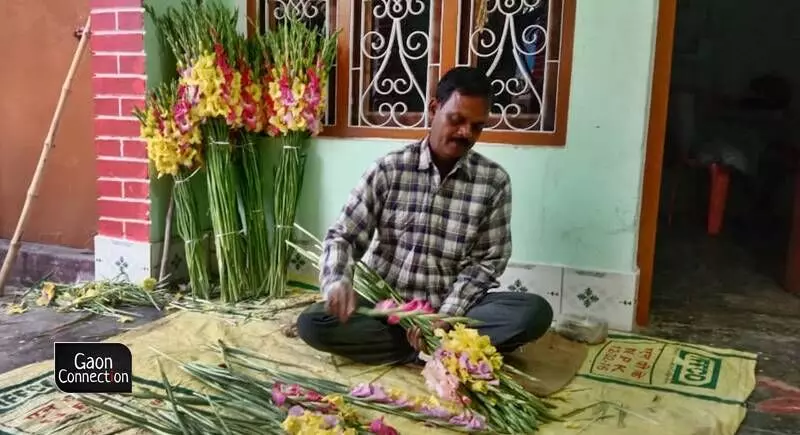Bishunpur (Barabanki)
Twenty years ago, Anil Verma, a farmer from Barabanki in Uttar Pradesh, was at his wits’ end. Despite his best efforts, the wheat and paddy he cultivated was not bringing him any joy.
“I faced losses harvest after harvest. Pest infestations, floods, poor market prices, or post-harvest losses, I was trapped in a vicious cycle,” Verma, told Gaon Connection.
The 50-year-old farmer from Bishnupur village did some introspection, he said and took the decision of switching over to cultivating gladiolus flowers. And, he has not had a single regret for doing that ever since.
“I have ensured my children get a higher education, I have married off my sisters and I live in a pucca home, and own a car — all thanks to the profits I made from the flowers. I would never have been able to do all this had I stuck to cultivating the traditional wheat and paddy,” he said.
Also Read: The bitter gourd is bringing sweet returns to farmers in Unnao, UP
Verma was one of the first in the district to cultivate gladiolus flowers. They are in great demand and are sent in great numbers to the neighbouring district of Lucknow as well as New Delhi.
Verma owns four acres [1.5 hectares] of land and he said that the input costs on cultivating an acre of the flowers was about Rs 100,000, while the profits per acre could go up to Rs 250,000.
“I start the cultivation in August and it takes about four months for the flowers to bloom — the harvest perfectly coincides with the wedding season in the country which begins in December,” Verma said. The demand for the flowers went up then and before the pandemic the farmer said he made a tidy profit.

Anil Verma was one of the first in the district to cultivate gladiolus flowers.
“I used to earn profits upto Rs 400,000 but it is reduced now. A single stalk of gladiolus sold for Rs 10, but now we get no more than Rs 6 or Rs 8 each,” he said.
Also Read: Kashmiri farmers move from paddy fields to apple orchards for higher returns
According to the Union Ministry of Agriculture and Farmers’ Welfare, gladiolus is being grown in an area of 11,660 hectares in India with an estimated production of 1,060 million cut flowers, making it the third largest flower crop in terms of acreage and cultivation.
“The other gladiolus producing states in the country are Uttar Pradesh, West Bengal, Odisha, Chhattisgarh, Haryana & Maharashtra as well as Uttarakhand, Karnataka, Andhra Pradesh and Sikkim. Even though gladiolus is mainly a winter season flower crop, in areas having moderate climatic conditions,they can be grown throughout the year,” the ministry’s notes on gladiolus cultivation mention.
An inspiration to many
Verma’s success at cultivating gladiolus has inspired many in and around his village to follow suit.

The gladiolus flowers are in great demand and are sent in great numbers to the neighbouring district of Lucknow as well as to New Delhi.
One such farmer resides in the Kabir Purwa village which is situated almost 15 kilometres away from Verma’s fields which are presently in full bloom.
“I started off with gladiolus cultivation in 2016. I grow these flowers on an acre of land and the profits reaped are several times more than what I used to earn by growing crops like paddy, wheat, corn, and sugarcane,” Amar Singh, a resident of Kabir Purva village, told Gaon Connection. “I am earning Rs 200,000 to Rs 250,000 a year from these flowers,” he added.
There are five types of gladiolus grown in the district: yellow, pink, American, white, and magenta.
The pandemic effect
Like it did with everything else, the pandemic has rocked the boat for the flower farmers.
“The last three-four years have seen a fall in income. One reason was of course the mahamaari [pandemic] which disturbed our supply chain. This led to artificial flowers flourishing. Only those who are really fond of flowers buy the real ones. These plastic flowers are a big headache for us,” Verma said.
The past year or so has also seen irregularities in the weather patterns.
“The excessive rainfall after October was disastrous for gladiolus. The acreage has reduced to almost half now,” Ganesh Chandra Mishra, assistant district horticulture officer in Barabanki told Gaon Connection.
Also Read: A village in Bihar goes organic, transforming the lives of its women
But, the government is doing all it can to encourage more farmers into cultivating gladiolus. Meanwhile, Mahesh Chandra Srivastava, the district horticulture officer, informed that the government has tried to encourage more farmers into taking up the cultivation of gladiolus flowers.
“Between 2005-2013, the government provided a subsidy of 25 per cent on the input costs of cultivation. We are trying to promote it,” Mahesh Chandra Srivastava, the district horticulture officer, told Gaon Connection. After the initial investment of about Rs 100,000 per acre, the cultivation is more economical as the seeds or the bulbs for the next crop is available from the previous one. The input costs then reduce to Rs 20,000 to Rs 25,000 per acre, Srivastava explained.

















